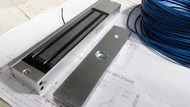Unlocking the Mysteries of Magnetic and Electric Strike Locks: A Security Expert's Take
Published by APEX Access Control on 22nd Jun 2023
Introduction:
Securing your property often feels like navigating through a labyrinth of technologies and terminology. While traditional locks have been around for centuries, the world has moved on to more advanced locking systems like Magnetic Locks and Electric Strike Locks. These modern marvels can feel a bit enigmatic, but fear not! As an expert in Door Entry and Access Control, let me decode these for you.
Magnetic Locks: The Pull of Security
Also known as Maglocks, these operate using an electromagnetic field. When the magnet is energised, it bonds to the metal plate on the door, securing it.
When to Use Magnetic Locks:
- High-traffic areas: Maglocks are ideal for places like corporate offices or educational institutions where people frequently come and go.
- Fire Exits: In compliance with safety regulations, Maglocks automatically disengage during power outages, making them a safe choice for emergency exits.
Strengths and Weaknesses:
Strengths: They're robust, with minimal moving parts to wear out, and quick to lock and unlock.
Weaknesses: They are power-dependent and may pose challenges during power failures unless backed up by a battery system.
Electric Strike Locks: The Strike of Versatility
Electric Strikes work alongside your existing mechanical locks. They're electrically powered mechanisms that move a latch, allowing or denying entry.
When to Use Electric Strike Locks:
- Residential Units: For flats or condos, Electric Strikes offer the benefit of easy integration with existing mechanical locks.
- Secure Zones within Buildings: Their dual locking/unlocking feature makes them ideal for areas that require a different level of security within the same building.
Strengths and Weaknesses:
Strengths: They're versatile and can switch between locked and unlocked states in case of power failures.
Weaknesses: They can be tricky to install and may require door modification.
The Key Considerations for Choosing Between the Two
- Level of Security: While both offer high levels of security, Electric Strikes work well for more compartmentalised security needs.
- Ease of Installation: Maglocks are generally easier to install, a factor that may be crucial for retrofitting older structures.
- Operational Costs: Consider not just the upfront cost but the long-term maintenance and energy consumption.
- Regulatory Compliance: Always cross-verify with local and federal building codes and fire safety norms before making your decision.
Why These Locks are Perfect for Advanced Door Entry and Access Control Systems
Both types of locks are highly compatible with modern security measures like biometric systems, key fobs, or card readers. This makes them a stellar choice for tech-savvy businesses and residences looking to step up their security.
APEX Verdict
Magnetic Locks and Electric Strikes are a powerful way to modernise your security infrastructure. While Maglocks are simpler and faster to operate, Electric Strikes offer greater flexibility. Your choice should be dictated by your property's specific needs and local regulatory guidelines.
Contact Us
In need of specialised guidance? Feel free to reach out to our team of experts for personalised consultation.

